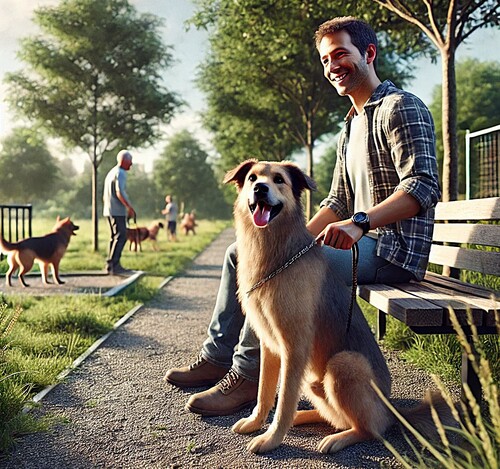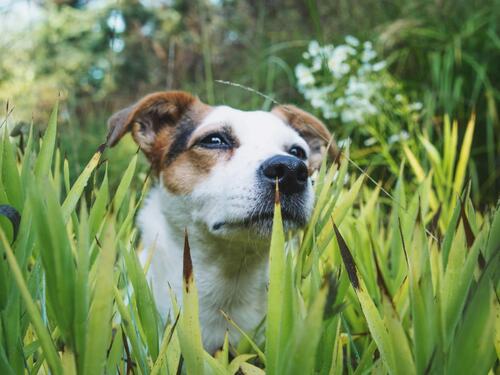Our Top 5 Tips for Landscaping a Dog Park
Introduction
Dog parks play a pivotal role in making cities more pet- and family-friendly, providing a safe, enclosed space where dogs can run freely and socialize. As urban environments continue to grow, the demand for well-designed, safe, and enjoyable dog parks is higher than ever. Not only do these parks benefit dogs, but they also foster a sense of community among pet owners.
But what goes into creating the perfect dog park? From space considerations to choosing the right materials, here are our top five tips for designing a dog park that serves the needs of both dogs and their owners.
1. Prioritize Space for the Dogs

Small Dogs Enjoy Running and Playing in a Fenced Grassy Dog Park
Space is the most important factor when planning a dog park. Dogs need room to run, explore, and engage with each other without feeling constrained. A dog park that is too small may lead to unwanted behaviors such as anxiety, aggression, and territorialism. Larger spaces allow dogs to interact more naturally, reducing the chance of conflict.
A good rule of thumb is to provide at least 5,000 to 10,000 square feet for an average dog park. However, if space allows, larger areas are always better. Ideally, the park should be spacious enough to accommodate both active dogs that need to burn off energy and more laid-back dogs that prefer to walk around and sniff.
Designating Separate Zones
In larger parks, consider dividing the space into zones based on the size and activity level of the dogs. For example:
- Large Dog Zone: For dogs weighing over 70 pounds, such as retrievers, German shepherds, and Great Danes.
- Medium Dog Zone: Ideal for dogs between 30 and 70 pounds, like beagles, border collies, and spaniels.
- Small Dog Zone: A dedicated area for dogs under 30 pounds, such as chihuahuas, pugs, and terriers.
This separation helps prevent injury and minimizes the risk of conflicts between dogs of different sizes. It also ensures that small dogs aren’t overwhelmed by their larger counterparts.
Maximize Open Space
When laying out the dog park, avoid overcrowding the area with unnecessary obstacles. Open running space should be prioritized, while agility equipment and other features can be added in moderation. Open space allows for natural behaviors like sprinting, chasing, and playing fetch, all of which are important for a dog’s mental and physical health.
2. Design with Pet Owners in Mind

A Dog and Owner Enjoying a Relaxing Day at a Spacious Dog Park
While the focus of a dog park is on creating a great experience for dogs, it’s equally important to consider the comfort and convenience of the owners. A well-designed park caters to both the dogs and their humans, encouraging socialization and repeat visits.
Essential Features for Pet Owners
- Trash Cans and Waste Stations: Conveniently placed trash cans and waste bag dispensers help owners clean up after their pets, keeping the park clean and sanitary. Regularly maintained waste stations reduce the risk of unpleasant odors and unsightly messes.
- Comfortable Seating: Pet owners spend a lot of time standing or walking while their dogs play, so providing ample seating in the form of benches or picnic tables is essential. Strategically place benches in shaded areas, allowing owners to relax and keep an eye on their pets in comfort.
- Water Fountains: Install dual-purpose drinking fountains that cater to both humans and dogs. This ensures that both pets and their owners stay hydrated during their visit, particularly on hot days.
- Covered Areas: Offering shaded, covered areas like gazebos or pergolas allows pet owners to escape the heat or rain. It also provides a place to store bags, leashes, and other personal items while their dogs play.
Socialization Spaces
Dog parks aren’t just for dogs! These parks often serve as social hubs where pet owners can meet, chat, and share tips. Consider designing a community area with a few picnic tables or benches where owners can gather. Some parks even offer community bulletin boards for posting local pet services, adoption events, and more.
3. Ensure Access to Fresh Drinking Water

A Dog Stands at a Low Water Fountain, Enjoying Hydration in the Park
One of the most overlooked elements of a dog park is the availability of fresh drinking water. Dogs, especially active ones, can overheat quickly when playing, making access to clean water critical. Installing water stations that are easy to access for both dogs and humans will prevent dehydration and help keep the park safer for all.
Types of Water Fountains
There are several types of water fountains to choose from when planning a dog park:
- Dual-use fountains: These fountains feature separate spouts for humans and dogs, allowing both to hydrate in the same location.
- Dog-specific fountains: These fountains are lower to the ground and are designed specifically for dogs. Some even feature sensors that allow the water to be activated when a dog is nearby.
Hydration Tips for Dog Owners
Consider placing hydration tips or signs around the park to remind owners of the importance of keeping their pets hydrated, especially during the warmer months. It’s also a good idea to have shaded areas near the water stations so dogs can rest and cool down after drinking.
4. Choose Safe, Durable Materials
The materials used in a dog park have a big impact on the park’s overall usability and maintenance requirements. Different surfaces work better in different climates, so it’s important to choose materials that are safe, durable, and low-maintenance.
Natural Grass vs. Artificial Turf
- Natural grass: Offers a soft surface that dogs love to roll and play on, but it requires regular watering, mowing, and patching. High foot traffic can cause wear and tear, leading to muddy spots during the rainy season.
- Artificial turf: A popular choice for its low maintenance, durability, and resistance to dog urine. However, it can get hot in the summer and may need to be hosed down regularly to remove odors.
Decomposed Granite and Other Materials
- Decomposed granite : A cost-effective and low-maintenance option that drains well and prevents muddy paws. It’s great for dry climates but can become dusty and unusable after rain.
- Rubber mulch: Made from recycled rubber, this material provides a cushioned surface for dogs to play on and is easy to maintain. However, it may not be suitable for very large parks or extremely hot climates.
- Pea gravel: A rounded, smooth gravel that is soft on dog paws, easy to clean, and durable.
Drainage Considerations
In addition to the materials, proper drainage is essential. Poor drainage can lead to muddy areas, making the park unusable after rain. Ensure that the park’s design allows water to drain away quickly, keeping the ground dry and comfortable.
5. Avoid Dangerous Plants

A Dog Peeking Through Tall Grass – Photo by Andreas Schnabl
Dogs love to explore, sniff, and sometimes even chew on plants. While it’s important to make a dog park look visually appealing with greenery, you need to be mindful of which plants are used. Some common plants are toxic to dogs and should be avoided in any dog park design.
Toxic Plants to Avoid
- Oleander: Highly toxic if ingested, oleander can cause vomiting, diarrhea, and heart issues in dogs.
- Azaleas: While beautiful, azaleas are toxic and can cause gastrointestinal problems, weakness, and even cardiac arrest.
- Sago Palm: Every part of the sago palm is toxic to dogs, causing severe liver damage.
- Foxglove: This plant is extremely dangerous and can cause heart failure if ingested.
Safe Plant Options for Dog Parks
Instead, opt for dog-friendly plants that can withstand wear and tear while posing no harm to curious dogs. Consider these options:
- Marigolds: Bright and cheerful, marigolds are safe for dogs and add a pop of color to any park.
- Roses: Thornless varieties of roses are both safe and beautiful.
- Magnolias: Magnolias provide shade and are nontoxic to dogs.
- Lavender: Not only is lavender safe for dogs, but its scent can also have calming effects on pets.
Incorporating native plants is another way to reduce maintenance needs and ensure that your landscaping is suited to the local climate.
Adding a Dog Park to Your Community
If you’re considering adding a dog park to your community, thoughtful planning and design are essential to creating a space that will be enjoyed by both dogs and their owners. A well-landscaped dog park can enhance community spirit, improve quality of life for residents, and become a popular gathering spot.
For residents of the San Francisco Bay Area, contact a local landscaping company for expertise in designing and maintaining dog parks. Their teams can help you create pet-friendly environments that are both functional and beautiful. Start planning the perfect dog park for your community!
Originally posted on August 11, 2019.


